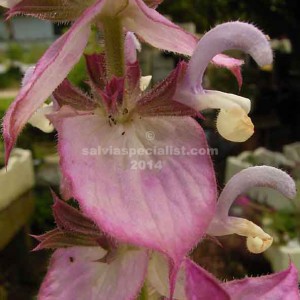Pictures of salvia sclarea are often found in ancient herb books. It has been used medicinally in Europe for hundreds of years. Probably most of the herb books came from that part of the world so it was often featured. It is often sold but not usually explained that it is inclined to have a short or 2 year life span. However it self seeds readily and sometimes to excess, so the short life span is not always a problem. It is best planted in autumn or late summer as it flowers in spring around rose time. Through winter the plant is low to the ground but come spring it heads up to more than a metre high.
Sclarea doesn’t mind dry and very cold, I can’t imagine it doing well in sub tropical once it got very humid. It should take any cold Australia can give it. It prefers sun though if it has got rather weedy it will probably come up anywhere!
Sclarea has rough hairy foliage and wouldn’t be interesting to eat just in case you got some benefits! Possibly its most well known medicinal use is for cleaning the eyes. You would have to have oil from the plant. The oil is also used in making perfume, though its foliage has a rather unpleasant smell to most people.
The wild sclarea has a fairly pale flower but the better varieties have outstanding heads of flowers after wonderful fat buds. Actually the main show is from bracts, the flowers are squeezed down among the bracts but most people wouldn’t analyse that.
I don’t grow the less interesting sclarea in case it cross pollinates. The most common best form is pink and known as turkestanica but there is also a white form which is not in stock at present
Price: $9

